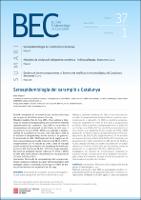Seroepidemiologia del xarampió a Catalunya
Abstract
Introduction. Measles is a virical disease that may be
serious in children aged >1 year.
Methods and results. Since 1985 six seroprevalence studies in representative
samples of the population have been carried out. Seroprevalence
of measles in children aged 6-14 years and pregnant women was studied in 1985; seroprevalence in population aged ≥5
years was studied in 1996 and 2003; and seroprevalence in neonates
and pregnant women was studied in 2003 and 2013. Studies carried
out in 1996 and 2002 (population aged ≥5 years) found a prevalence
of protective levels of 98.5% and 95.5%, respectively. Studies
carried out in 2003 and 2013 in neonates (umbilical cord) found
prevalence of protective levels (>300 UI/ml) of 98.6% and 91.5%,
respectively. Protective levels had decreased 7% between 2003 and
2013 due to the lower protective levels in pregnant women aged <35
years (<91%) in 2013.
Conclusions. The studies of seroprevalence carried out in Catalonia
suggest that great part of the population is protected against
measles, although immunity levels have decreased in population
aged <35 years.
Keywords
Seroprevalence; Measles; IgG antibodiesBibliographic citation
Plans-Rubió P. Seroepidemiologia del xarampió a Catalunya. Butll Epidemiol Catalunya. 2016;37(1):1-6.
Audience
Professionals
This item appears in following collections
- DS - Articles científics [409]
The following license files are associated with this item:

 Private area
Private area Contact Us
Contact Us








